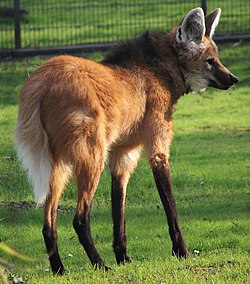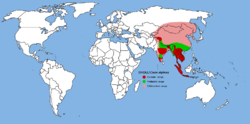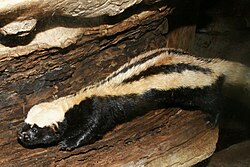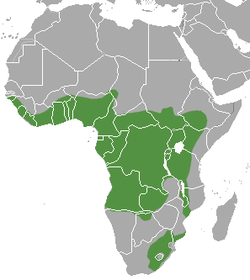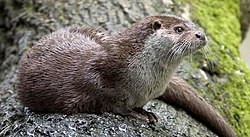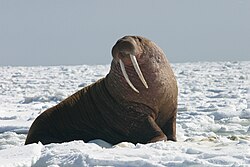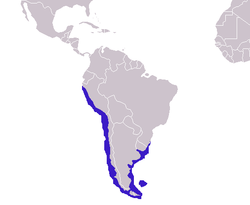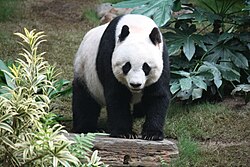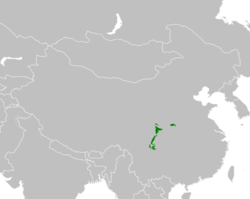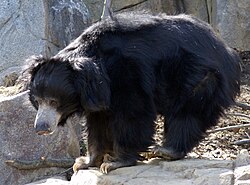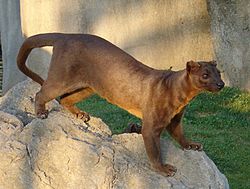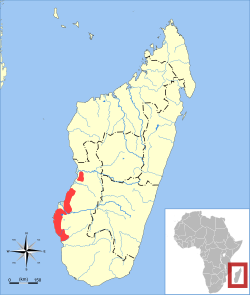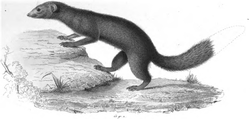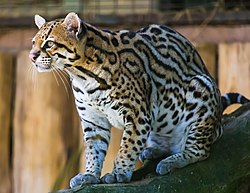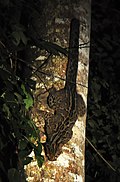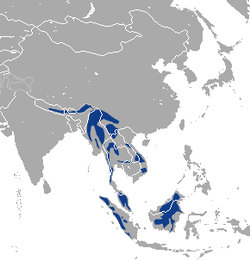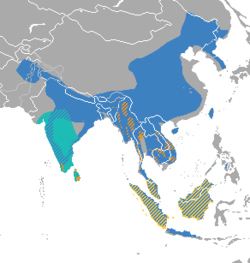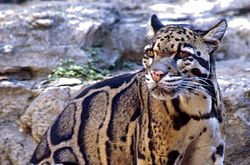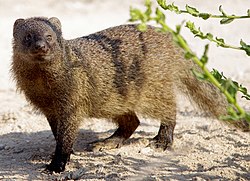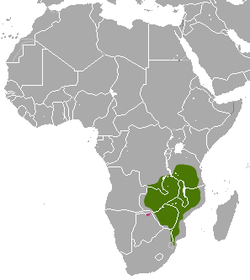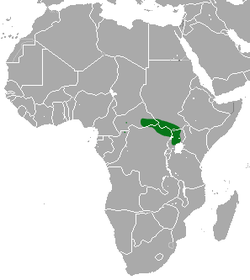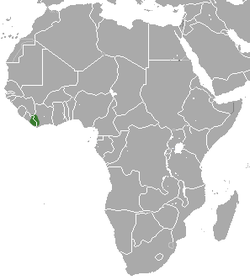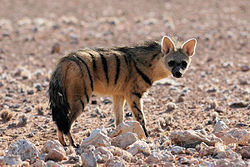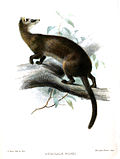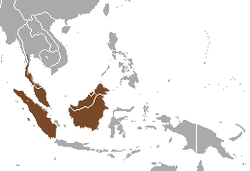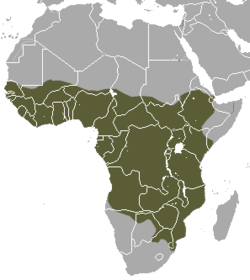Top Qs
Timeline
Chat
Perspective
List of carnivorans
Animals in mammal order Carnivora From Wikipedia, the free encyclopedia
Remove ads
Carnivora is an order of placental mammals that have specialized in primarily eating flesh. Members of this order are called carnivorans, or colloquially carnivores, though the term more properly refers to any meat-eating organisms, and some carnivoran species are omnivores or herbivores. Carnivora is the fifth largest order of mammals and currently comprises 291 extant species, which are grouped into 131 genera. Carnivora can be divided into two suborders: the cat-like Feliformia and the dog-like Caniformia, which are differentiated largely based on the structure of their ear bones and cranial features.[1] The majority of feliform species are found in the Old World, though the cats have successfully diversified into the Americas. Members of the Caniformia group are found worldwide. Carnivorans live on every major landmass and in a variety of habitats, including polar regions, hyper-arid deserts, and the open seas. They come in a wide array of body plans in contrasting shapes and sizes, ranging from the 17 cm (7 in) least weasel to the 6 m (20 ft) and 3,700 kg (8,200 lb) male southern elephant seal. Some carnivorans, such as cats, dogs, and the ferret, have been domesticated, resulting in a worldwide distribution.

The feliforms are further subdivided into seven families: Eupleridae, Felidae, Herpestidae, Hyaenidae, Nandiniidae, Prionodontinae, and Viverridae, and include the cats, the hyenas, the mongooses and the viverrids, among others. The caniforms are divided into nine families: Ailuridae, Canidae, Mephitidae, Mustelidae, Odobenidae, Otariidae, Phocidae, Procyonidae, and Ursidae, and include the dogs, bears, raccoons, weasels, and pinnipeds. The exact organization of the species is not fixed, with many recent proposals made based on molecular phylogenetic analysis, including smaller re-categorizations such as promoting the black mongoose subspecies of the slender mongoose to a full species or the 2011 discovery of the Vietnam ferret-badger, as well as larger changes such as formally recognizing the family Eupleridae as separate from Viverridae and Herpestidae in 2003. In addition to the extant species, six species have gone extinct since 1500 CE: the Falkland Islands wolf and South American fox in Canidae, the sea mink and Japanese otter in Mustelidae, the Japanese sea lion in Otariidae, and the Caribbean monk seal in Phocidae.
Remove ads
Conventions
The author citation for the species or genus is given after the scientific name; parentheses around the author citation indicate that this was not the original taxonomic placement. Range maps are provided wherever possible; if a range map is not available, a description of the collective range of species in that genera is provided. Ranges are based on the International Union for Conservation of Nature (IUCN) Red List of Threatened Species unless otherwise noted. All extinct genera or species listed alongside extant species went extinct after 1500 CE, and are indicated by a dagger symbol "†".
Remove ads
Classification
Summarize
Perspective

The order Carnivora consists of 291 extant species belonging to 131 genera as well the extinct genus Dusicyon, comprising 2 extinct species, and 4 other extinct species, which are the only carnivoran species to go extinct since prehistoric times. This does not include hybrid species (such as wolfdogs or ligers) or extinct prehistoric species. Modern molecular studies indicate that the 131 genera can be grouped into 16 families, split into the Caniformia and Feliformia clades, and several of these families are subdivided into named subfamilies. Three families of semi-aquatic animals, Odobenidae, Otariidae, and Phocidae, are collected into the suborder Pinnipedia.
Suborder Caniformia
- Family Ailuridae
- Subfamily Ailurinae (red pandas): 1 genus, 1 species
- Family Canidae
- Subfamily Caninae (wolves and foxes): 14 genera (one extinct), 39 species (two extinct)
- Family Mephitidae (skunks and stink badgers): 4 genera, 12 species
- Family Mustelidae
- Subfamily Guloninae (martens and wolverines): 4 genera, 9 species
- Subfamily Helictidinae (ferret-badgers): 1 genus, 5 species
- Subfamily Ictonychinae (African polecats and grisons): 5 genera, 7 species
- Subfamily Lutrinae (otters): 7 genera, 14 species (one extinct)
- Subfamily Melinae (Eurasian badgers): 2 genera, 6 species
- Subfamily Mellivorinae (honey badger): 1 genus, 1 species
- Subfamily Mustelinae (weasels and minks): 2 genera, 20 species (one extinct)
- Subfamily Taxidiinae (American badger): 1 genus, 1 species
- Clade Pinnipedia
- Family Odobenidae (walrus): 1 genus, 1 species
- Family Otariidae (eared seals): 7 genera, 16 species (one extinct)
- Family Phocidae (true seals): 14 genera, 19 species (one extinct)
- Family Procyonidae (raccoons, coatis, olingos, kinkajous): 6 genera, 14 species
- Family Ursidae
- Subfamily Ailuropodinae (panda bear): 1 genus, 1 species
- Subfamily Tremarctinae (short-faced bear): 1 genus, 1 species
- Subfamily Ursinae (bears): 3 genera, 6 species
Suborder Feliformia
- Family Eupleridae
- Subfamily Euplerinae (civet-like euplerids): 3 genera, 4 species
- Subfamily Galidiinae (mongoose-like euplerids): 4 genera, 6 species
- Family Felidae
- Subfamily Felinae (small and medium-sized cats): 12 genera, 34 species
- Subfamily Pantherinae (large cats): 2 genera, 7 species
- Family Herpestidae
- Subfamily Herpestinae (European/Asian mongooses): 9 genera, 23 species
- Subfamily Mungotinae (African mongooses): 6 genera, 11 species
- Family Hyaenidae (hyaenas): 3 genera, 4 species
- Family Nandiniidae (African palm civet): 1 genus, 1 species
- Family Prionodontidae (Asiatic linsangs): 1 genus, 2 species
- Family Viverridae
- Subfamily Genettinae (genets): 2 genera, 16 species
- Subfamily Hemigalinae (Southeast Asian civets): 4 genera, 4 species
- Subfamily Paradoxurinae (Asian civets): 5 genera, 7 species
- Subfamily Viverrinae (civets): 3 genera, 6 species
Remove ads
Carnivorans
Summarize
Perspective
The following classification is based on the taxonomy described by Mammal Species of the World (2005), with augmentation by generally accepted proposals made since using molecular phylogenetic analysis, including smaller re-categorizations such as promoting the black mongoose subspecies of the slender mongoose to a full species or the 2011 discovery of the Vietnam ferret-badger, as well as larger changes such as formally recognizing the family Eupleridae as separate from Viverridae and Herpestidae in 2003.[2][3][4]
Suborder Caniformia
Ailuridae
The Ailuridae family is composed of one species, commonly called the red panda.
Canidae
Members of the Canidae family are canids and include domestic dogs, wolves, coyotes, foxes, jackals, and dingoes, among others. Canidae comprises 37 extant species, divided into 14 genera and placed inside a single extant subfamily, Caninae. Caninae is split into two tribes: Canini, comprising the wolf-like canids, and Vulpini, the fox-like canids.
Mephitidae
Members of the Mephitidae family are mephetids and include the skunks and stink badgers. Mephitidae comprises twelve extant species, divided into four genera, and is not split into subfamilies.
Mustelidae
Members of the Mustelidae family are mustelids and include weasels, badgers, otters, ferrets, martens, minks, and wolverines, among others. Mustelidae is the largest family in Carnivora, and comprises 62 extant species, divided into 23 genera. These genera are split into 8 subfamilies: Guloninae, martens and wolverines; Helictidinae, ferret-badgers; Ictonychinae, African polecats and grisons; Lutrinae, otters; Melinae, Eurasian badgers; Mellivorinae, the honey badger; Mustelinae, weasels and minks; and Taxidiinae, the American badger.
Clade Pinnipedia
Pinnipedia is an infraorder of carnivores, composed of seals, sea lions, and the walrus. A member of this group is called a pinniped or a seal. The clade contains three families: Odobenidae, comprising the walrus; Otariidae, the eared seals, split between the sea lions and fur seals; and Phocidae, the earless or true seals. Odobenidae and Otariidae are combined into the superfamily Otarioidea, with Phocidae in Phocoidea. These families are not subdivided into subfamilies.
Odobenidae
The Odobenidae family is composed of a single extant species, the walrus.
Otariidae
Members of the Otariidae family are otariids, or colloquially eared seals. There are sixteen species of sea lions and fur seals in Otariidae, divided into seven genera.
Phocidae
Members of the Phocidae family are phocids, or colloquially earless or true seals. There are nineteen species of seals in Phocidae, divided into fourteen genera.
Procyonidae
Members of the Procyonidae family are procyonids and include raccoons, coatis, olingos, kinkajous, ring-tailed cats, and cacomistles, among others. Procyonidae comprises fourteen extant species, divided into six genera.
Ursidae
Members of the Ursidae family are ursids, or colloquially bears. Ursidae comprises three extant subfamilies: the monotypic Ailuropodinae, the panda bears; Tremarctinae, the short-faced bears; and Ursinae, containing all other extant bears. There are eight extant species in Ursidae, divided into five genera.
Suborder Feliformia
Eupleridae
Members of the Eupleridae family are euplerids, or colloquially Malagasy mongooses or Malagasy carnivorans. Eupleridae comprises two extant subfamilies, the civet-like Euplerinae and the mongoose-like Galidiinae. Historically, the Euplerinae species were included in the civet family Viverridae, and several of the Galidiinae species in the mongoose family Herpestidae, but more recent genetic evidence showed them to be part of the same clade, having evolved from a single ancestor species 18–24 million years ago. There are 10 extant species in Eupleridae, divided into 7 genera.
Felidae
Members of the Felidae family are felids, or colloquially cats; "cat" refers both to felids in general and specifically to domestic cats. Felidae comprises two extant subfamilies, Felinae (small cats) and Pantherinae (large cats). There are 34 extant species in Felidae, divided into 14 genera.
Herpestidae
Members of the Herpestidae family are herpestids, or colloquially mongooses. Herpestidae comprises two extant subfamilies, Herpestinae, comprising the species that are native to southern Europe, Africa and Asia, and Mungotinae, comprising the species native to Africa. There are 34 extant species in Herpestidae, divided into 15 genera.
Hyaenidae
Members of the Hyaenidae family are hyaenids, or colloquially hyenas. Hyaenidae comprises four extant species, divided into four genera.
Nandiniidae
The Nandiniidae family is composed of a single extant species, the African palm civet.
Prionodontidae
The Prionodontidae family is composed of a single extant species in a single genus.
Viverridae
Members of the Viverridae family are viverrids, and the family is composed mainly of the civets and genets. Viverridae comprises four extant subfamilies, the 3 civet subfamilies Viverrinae, Hemigalinae, and Paradoxurinae, and the genet subfamily Genettinae. There are 33 extant species in Viverridae, divided into 14 genera.
Remove ads
See also
References
Sources
Wikiwand - on
Seamless Wikipedia browsing. On steroids.
Remove ads









